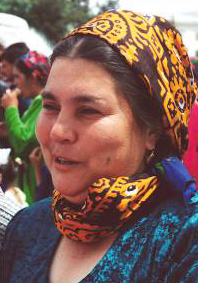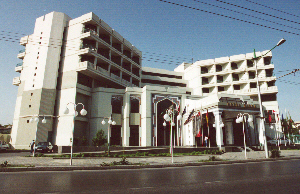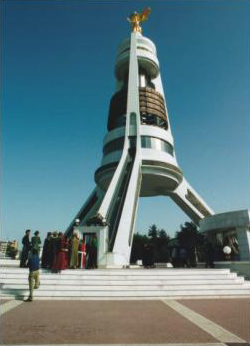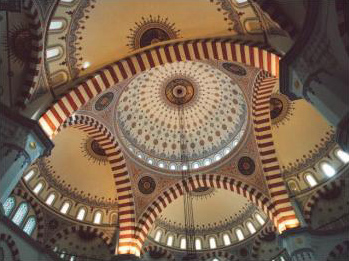Turkmenistan & Uzbekistan
Day 1 - Saturday, 22 April 2000
We flew to Ashgabat, Turkmenistan from Istanbul

The tour began in Istanbul, where most of us caught the same plane to Ashgabat, Turkmenistan. Several people were arriving from the U.S. with a one-hour window to make the connection. It was too tight. However, the Turkish Airlines (THY) plane waited for them, and soon we were in the air, winging toward our new adventure.
A tour group from Israel was on the same plane. Their tour guide, Alex, invited Meli to come and sit by him so that they could exchange professional tips, and perhaps make plans to work together in the future. Networking was happening in the air.
When we landed at Ashgabat, we had to pass through customs. There was only one agent, and we were two tour groups, plus the regular people. Alex became impatient and demanded more agents. After a flurry, we did get another agent. Some of us wanted to take pictures, but the atmosphere was not welcoming, and we felt we should ask permission. We were granted permission to photograph only one "welcome to Turkmenistan" sign, but not the Arthur Andersen advertisement, and definitely not the young uniformed soldiers?
Eventually we passed through customs, out on the street and in the bus. Some of the one-hour-window people were missing luggage so we waited for them to do paperwork. In the meantime, we enjoyed the colorful "fashion show." I was still shy about taking pictures, and missed one in particular that would have been a significant statement. Four people, three women and a child were dressed in four different dayglow colored dresses - blue, green, orange and yellow. It was a preview of things to come. Most of the women were wearing the traditional dress, simply cut, long sleeves, not-quite-to-the-ankle length, an embroidery around the neck - in those wonderful, glorious colors.
Many of the local women from the plane retrieved great bundles tied up in string. They had been on shopping trips to Istanbul, and the bundles contained items they would resell in the bazaars here in Turkmenistan. This is a way for them to make money, and this traffic is called "Suitcase Trade."

As the bus headed toward the hotel, our attention was drawn to a distant line of mountains, vague in the haze, which separate Turkmenistan from Iran. It didn't look so very far away.
Ashgabat was destroyed by an earthquake on October 6, 1948, so virtually the whole city has been rebuilt since then. The avenues are wide, buildings are set back from the street, and everything looks modern. Approximately 100,000 people were killed in the earthquake, and it is clear that a lesson was learned. The construction sites we saw in progress displayed impressive amounts of rebar.
The next morning breakfast was available from 7 a.m., and we were on our own until noon. It gave time for photos of the palace, the new congress building, and the marvelous statuary. Some people visited a small local bazaar.

When we were on the bus headed out for lunch, we caught sight of a wedding party, and stopped for photographs. There were two brides. One was completely covered and hidden behind her colorful veil and we learn there is a 40-day difference between her ceremony and the second one, whose face was uncovered. The second one was heavily laden with traditional jewelry.
Lunch was at an Iranian restaurant, and there was already too much food on the table when we arrived. However, it was only the first course! We murmured to each other about the waste, but realized it was probably the local idea of hospitality. Nevertheless, it concerned us deeply to see so much food so elaborately prepared, that would be wasted.
After lunch, we stopped at the carpet museum and saw many very old and wonderful carpets. Some of our men took note that every carpet was wired for security. Every carpet tells a story, every design in the carpet has a meaning. The larger element in the design is called a "lake" or "footprint of a baby camel." The smaller element is called a "frog" or a "spoon." An example of the meaning of one element, a tablecloth and dish, is hospitality. This is of major importance to the people, the guest is to be treated most graciously of all. We would see the truth of this in the days to come.
There is a saying, "Roll out your carpet and I will read your dreams." The woman who wove the carpet, wove into it her own heart's desires, especially if it was her wedding carpet.
Another saying is, "Water is life, horses are wings, and the carpet is the soul, or heart."
While in the museum, we had an opportunity to see young women at work on newer carpets. In a special exhibit, we saw one of the the largest carpets in the world. The room and the wall had to be specially built to display it.

After the museum, we visited a mosque where we were welcomed by the Imam. We sat in a corner and learned from him. This mosque is the largest in Central Asia, and it emulates the Blue Mosque in Istanbul. The Imam was trained in Turkey. The difference in the practice of Islam here as compared to Turkey, included the following items. In Turkey, Imams must have the heel covered, and they wear regular pants. In Turkmenistan the heel is uncovered, and the men wear the traditional baggy Turkmen pants, and they also wear a hat. There is also a difference in the rituals of how they wash the body of a dead person, but we did not get details. In Turkey, an important thing concerns how much a man must pay a woman if they get divorced. In Turkmenistan, there are no questions, they just cut with scissors over the head and they are divorced. In response to a question, we learn that the Koran is not widely read by the people, the Imam teaches them what they need to know.
The Imam sang for us the call to prayer in his beautiful voice. But he does not sing it over the minaret loudspeaker five times a day as they do in Turkey. He said the people are supposed to know when it is time to pray. In addition to his beautiful voice, we observe that he is also a handsome man, with dimples!
Dinner was at a Turkish restaurant, where we once again had too much food. (I should note here that the food in these two restaurants was very good, a lot of variety, and we enjoyed it. Later, we might wish we had some of it, when the diet became monotonous with sticky white rice and mutton as the main elements, repeated every day.)
The Turkish restaurant had live music (loud), and a belly dancer. At a back table, a birthday party for a young woman was in progress. Bouquet after bouquet of flowers were given to her as her guests arrived. One bouquet was two dozen deep red roses, with stems at least 24 inches long. The party consisted of about seven couples. At least they arrived in the restaurant as couples, but immediately the women went to the left end of the table and the men went to the right. Soon we noticed that there was a line of bottles, dividing the table. We saw the women toast each other as a group, and separately, the men toasted as a group. No crossover! When the belly dancer was performing, the women watched, the men did not - they continued their own conversation and politely ignored her.